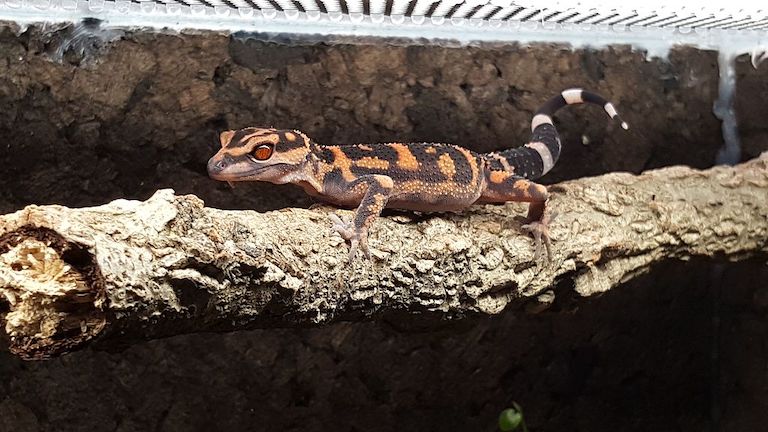- A new study found that only 9% of traded reptile species have some level of protection under CITES, the global wildlife trade convention, which could allow for the overexploitation of wild populations.
- It also found that about 90% of traded reptile species had at least some individuals originating from the wild rather than captivity, and that newly described species often appeared in the trade within a year of studies identifying these species were published.
- The authors of the study are advocating for a reversal in the CITES process to only allow the trade of certain species and ban the trade of all other species.
In 2019, conservation scientist Alice Hughes traveled to Geneva to attend a meeting for the Convention on International Trade in Endangered Species (CITES), a multilateral agreement aimed to protect endangered wildlife and plants by either banning or limiting their international trade. When members proposed giving protection to various species of Asian songbirds and tropical fish, which were heavily traded as exotic pets, these proposals were denied, Hughes said. Instead, the focus remained on more charismatic, “high-value” animals.
“In both cases, it was said to be too expensive to list that number of species, which basically got me thinking, ‘Well, if these species that are clearly under significant threat from trade are not being covered, how many other species that are in trade are [not being covered]?” Hughes told Mongabay.

These concerns prompted Hughes and two colleagues, Benjamin Marshall and Colin Strine, to undertake a study on the global wildlife trade, focusing specifically on reptiles, to understand how unregulated and under-regulated trade can affect wild populations. The results were published last month in Nature Communications.
“Reptiles were ideal as only 9% were monitored by CITES and much of the trade is online,” Hughes said.
The researchers gathered data from three main sources: the CITES trade portal, wildlife import records from the U.S. Fish and Wildlife Service’s Law Enforcement Management Information System (LEMIS) database, and an online webscrape of reptile retailers that looked at 25,000 webpages based on keywords in five languages.
They found that between 2000 and 2019, nearly 4,000 reptile species were caught up in the trade, including many endangered, critically endangered and range-restricted species, as well as species without population data or conservation assessments. If a species is not protected under CITES or other international protection measures, its trade is completely legal.

The study found that about 90% of traded reptile species had at least some individuals coming from the wild, and that about 55% of traded reptile individuals originated from the wild rather than captivity. For lizards, 75% were found to be taken from the wild, according to the study. It also indicated that newly discovered species were appearing for sale online shortly after they were identified in published studies.
“I knew that species descriptions were being used to identify species that could be potentially novel pets, but we found over 130 species described since 2000 they were already in trade with some of them in trade the same year they were described,” Hughes said. “We were astonished because, of course, these species have no baseline regulation.”
Sandra Altherr, co-founder of ProWildlife, a German animal welfare and species protection group, said the findings of this study were not unexpected, as ProWildlife has also found that the majority of traded reptile species are not covered by international protection measures.
“But what surprised us is the huge number of species Marshall and his colleagues recorded,” Altherr told Mongabay in an email. “Almost 4,000 reptile species in the pet trade is a shocking result, especially when you have in mind that most of them are not covered by CITES and hence exploitation of wild populations is neither regulated nor even recorded. CITES is a helpful tool to limit trade in threatened species but the process is too slow to combat the huge numbers of threatened non-CITES species and the trade dynamics, which is permanently shifting to new species.”

Hughes said she and her colleagues are advocating for a reversal of the CITES regulation process: instead of allowing species to be freely traded until they are given protection under CITES, they want CITES to generate a list of species that can be legally traded, and for the trade of all other species to be banned.
“As long as we have a system where you have to wait for a CITES regulation to say it can’t be traded [or] it can be traded, we’re going to have unsustainable exploitation,” Hughes said. “What we need to have is CITES defining a list of species that can be traded, be it coming from captivity, or the wild.”
“We fully support the authors conclusion and recommendation that a reversal of the status-quo would be needed, requiring proof of sustainability before trade is permitted,” Altherr said. “Field herpetologists fear to publish localities of new species, as those could be immediately targeted by collectors — long before CITES could react and long before other protection measures could be installed.”
Citation:
Marshall, B. M., Strine, C., & Hughes, A. C. (2020). Thousands of reptile species threatened by under-regulated global trade. Nature Communications, 11(1). doi:10.1038/s41467-020-18523-4
Banner image caption: A newly described Cyrtodactylus species from Myanmar that quickly entered the global pet trade. Image by Benjamin Marshall.
Elizabeth Claire Alberts is a staff writer for Mongabay. Follow her on Twitter @ECAlberts.
FEEDBACK: Use this form to send a message to the author of this post. If you want to post a public comment, you can do that at the bottom of the page.
